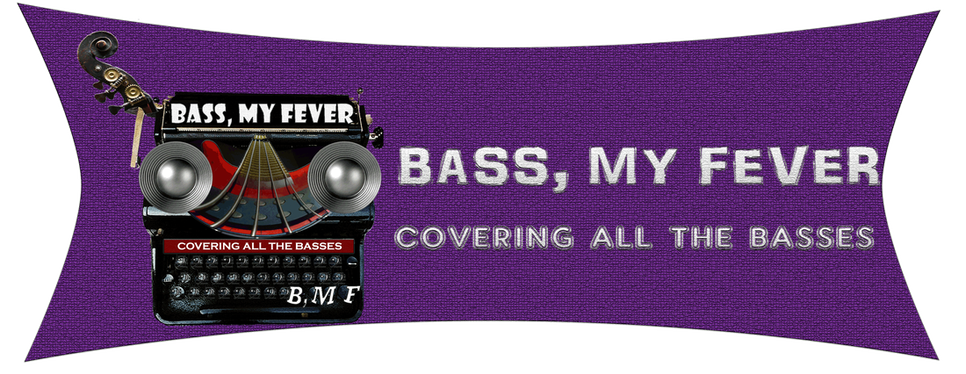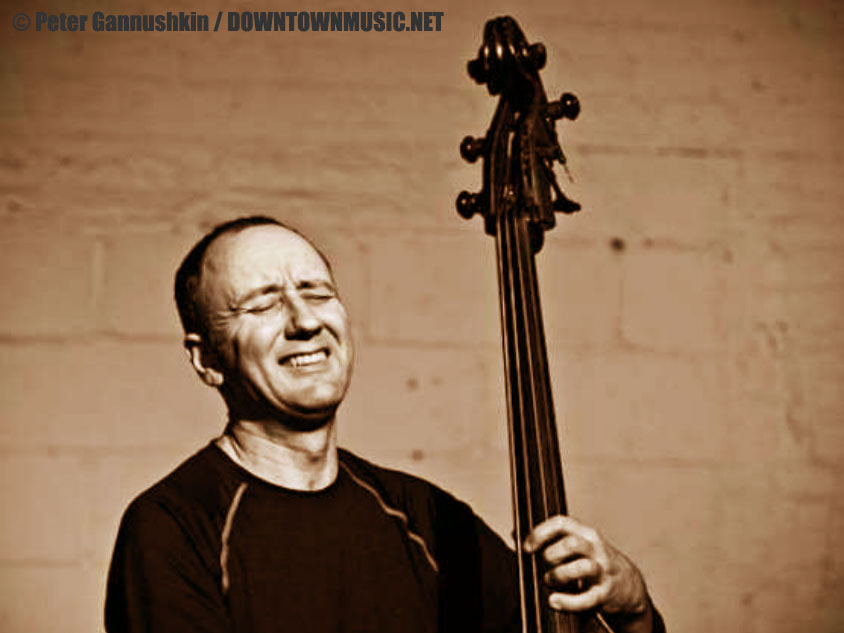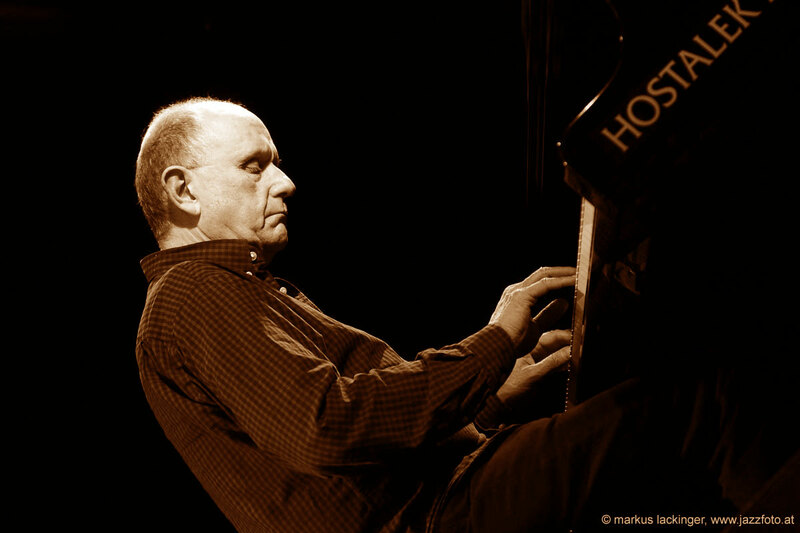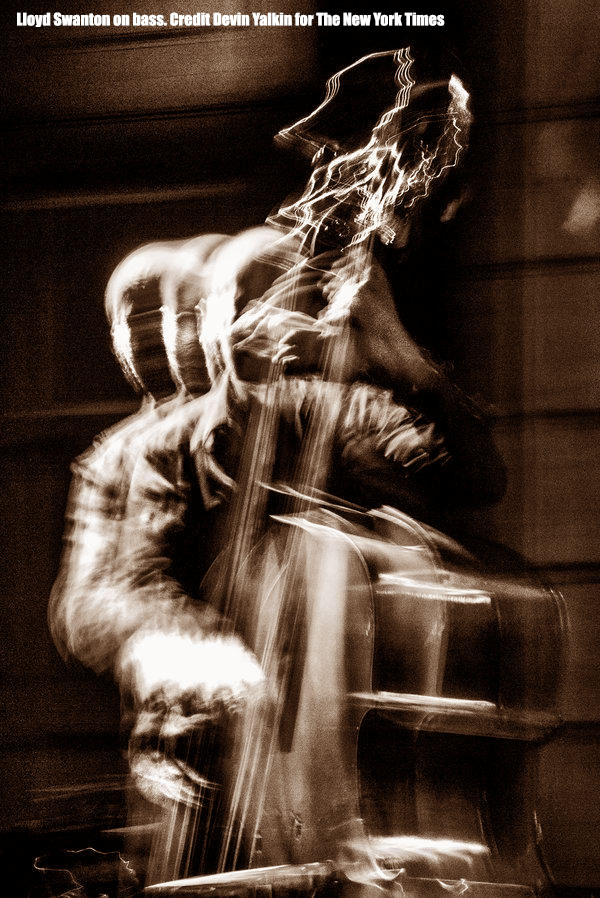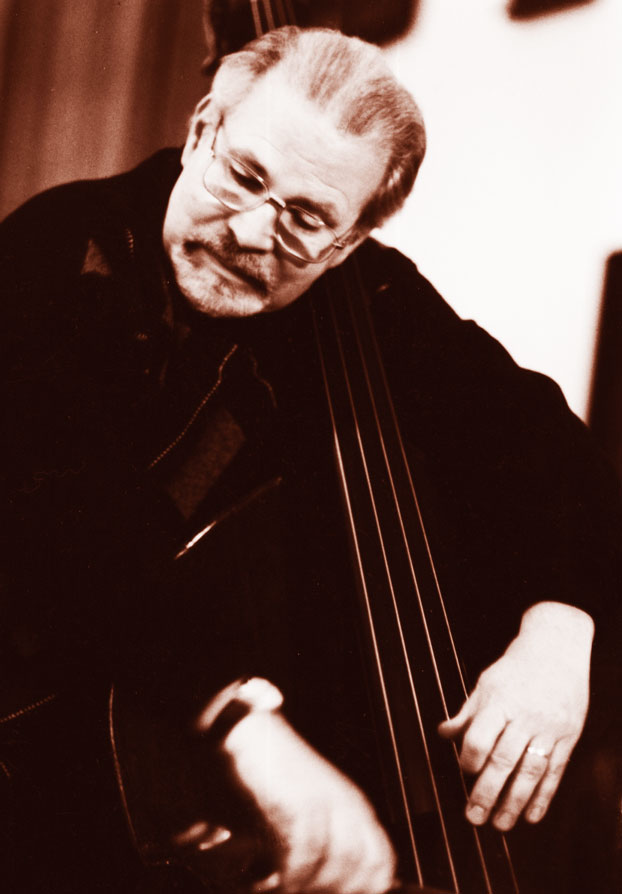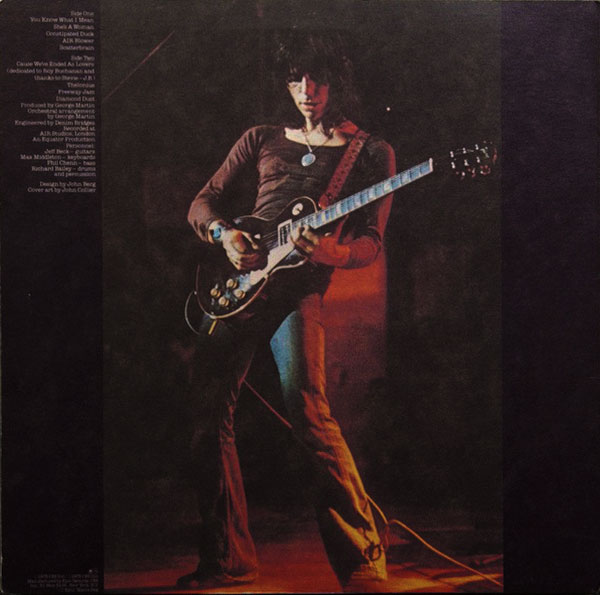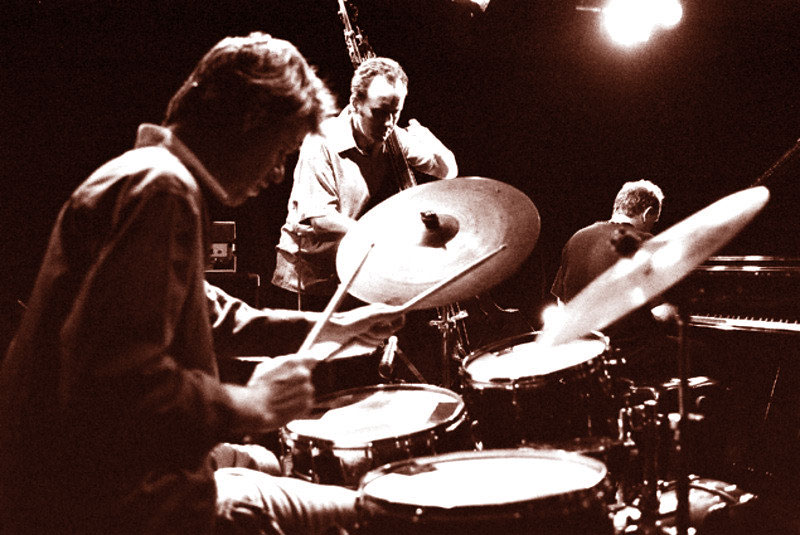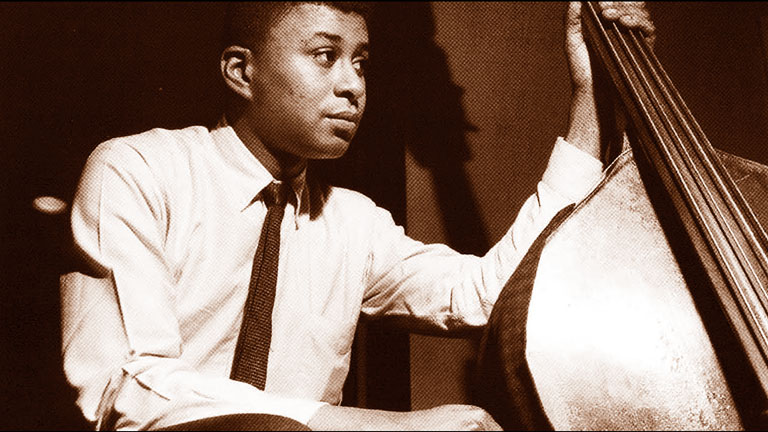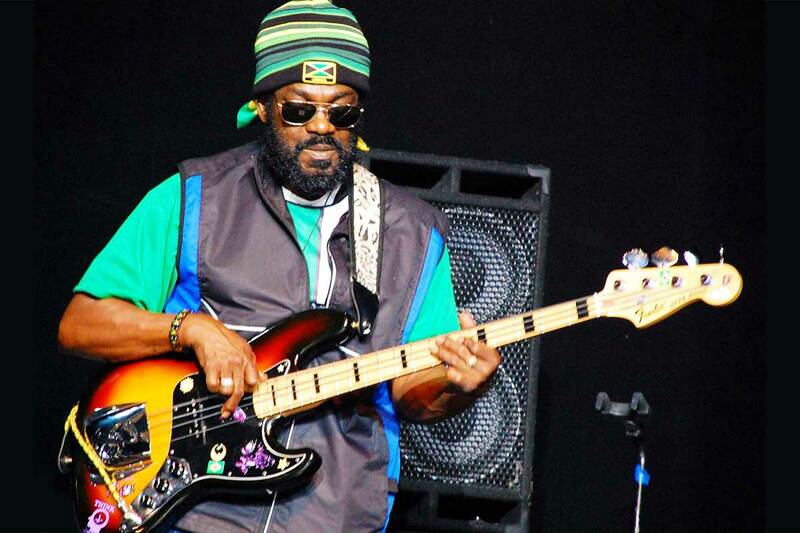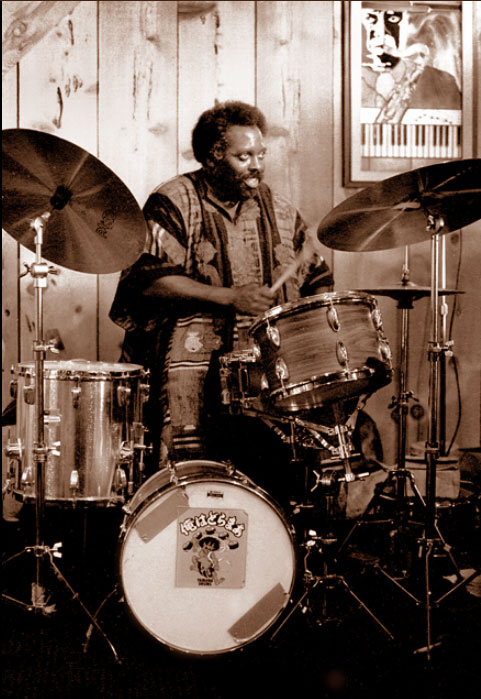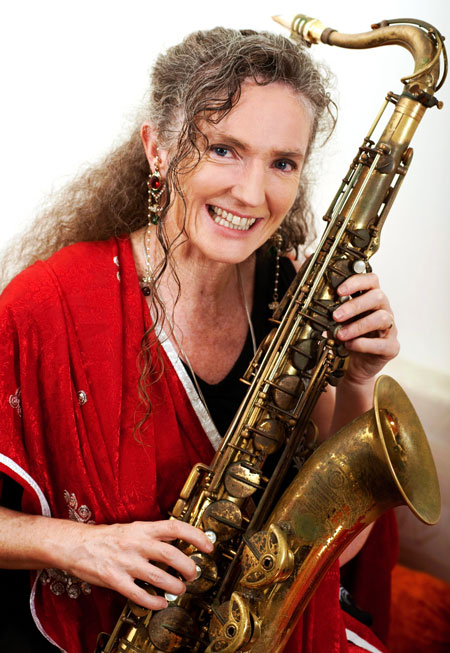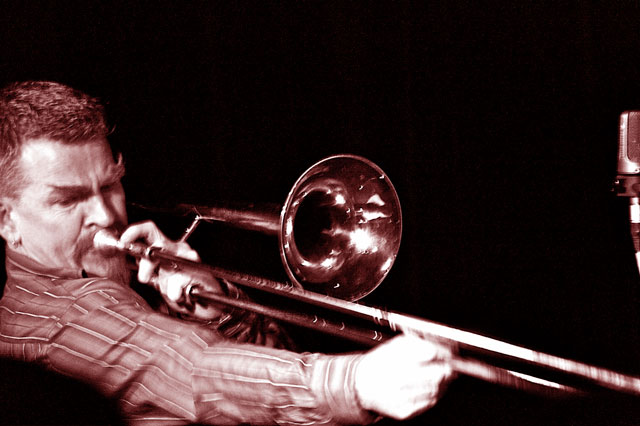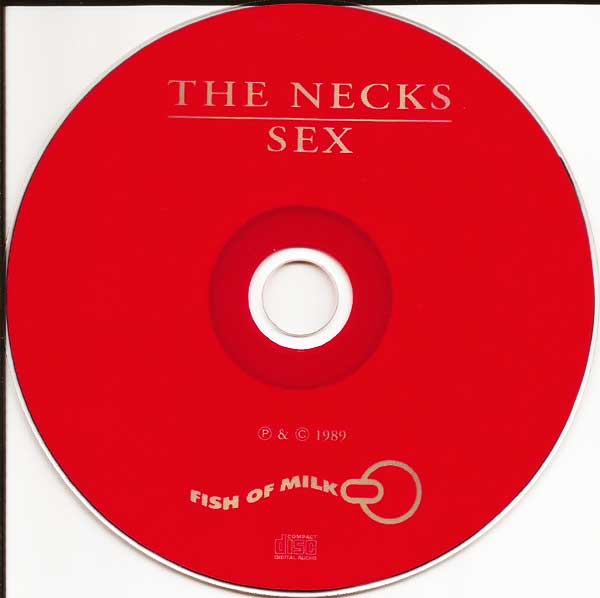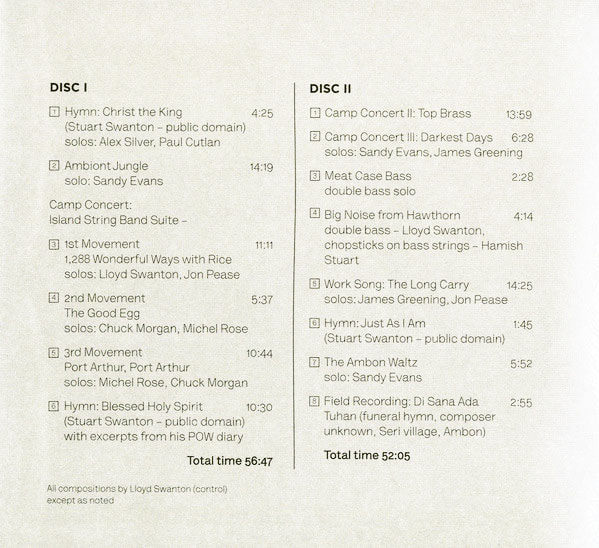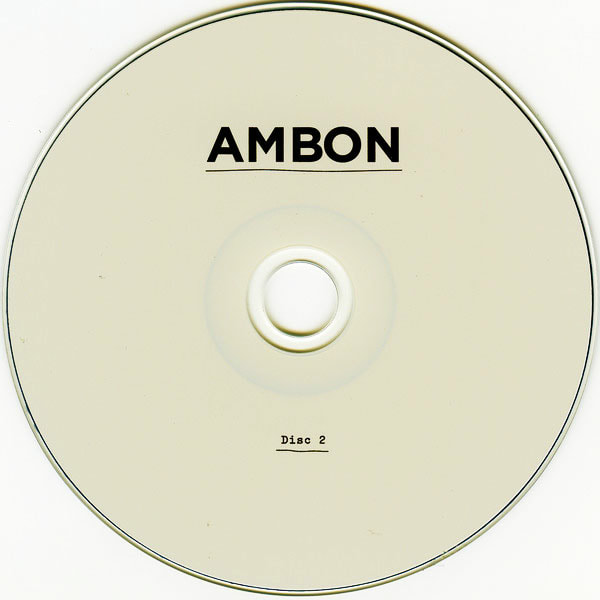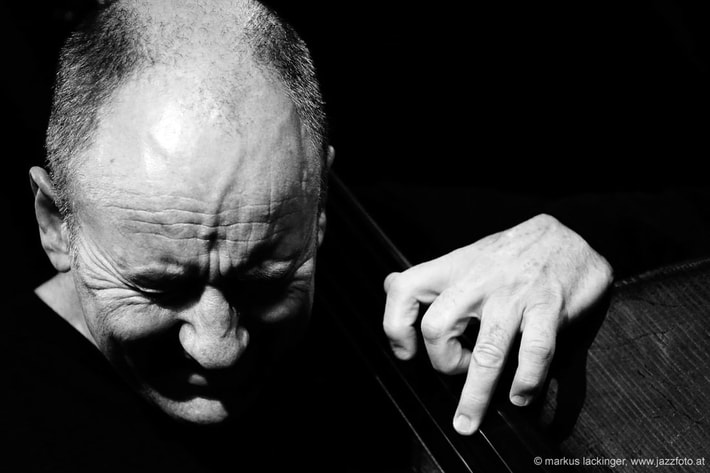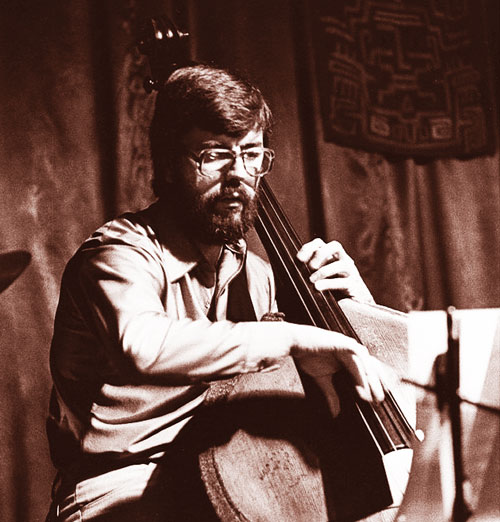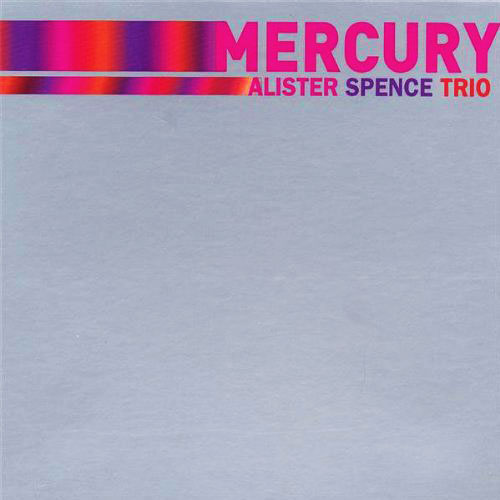|
«Just the fact that you embrace a double bass like you’re putting your arms around a person - there’s nothing else like that. Acoustic has that lovely fat, woody grain to its tone, so that you can focus on just playing the right notes at the right time, and that’s usually enough for a given situation. Electric makes you have to think more about movement and activity» |
|
In the late ‘80s Lloyd Swanton together with drummer Tony Buck and pianist Chris Abrahams, started a trio which enhanced an important development of both trio concept and interplay themselves, that is to say The Necks. At every level of taste and genre, it’s impossible not to be fascinated by this strange and wonderful creature capable of creating works of absolute originality, which are almost always based on a single long hypnotic track and at the same time they’re always on the move. |
|
As both a key figure of the Australian jazz and a double bass player of great sensitivity and extreme value, Lloyd Swanton is today a reference point for many people devoted to the notes of double bass. Each Necks album should deserve a comprehensive study, but here in order to introduce the interview so kindly given by Lloyd, we also want to remember his own creation as a leader, The catholics (c is strictly small), which is an attractive combo with about ten remarkable albums under its belt; the latest ones have been released by the Bugle Records, which is the label managed by the same Lloyd. |
A SELECTION OF THE CATHOLICS ALBUMS
|
And we must not forget what is at the moment the only solo record of Lloyd Swanton called Ambon, a fascinating concept album based on the real Stuart Swanton’s story - Lloyd’s uncle - who was imprisoned during the second war in Indonesia. This is a narrative and jazz tableau of great originality, where the clever playing of Swanton’s double bass paints the key aspects of the history with a clear strength. In the end we’re talking about a musician of high level with a complete view of jazz and his own instrument, an artist who surely will create other gems in varying different forms of his cultured and refined expression. |
|
BMF: First of all, would you like to tell us how you came to bass (both double bass and electric bass)?
LLOYD SWANTON: It’s a long story, one that was set in motion long before I was born. My father, who worked in the insurance business, was a keen violinist. He was living in Adelaide, Australia, in the 1930s, and bought a double bass because he thought it would be fun to play. He went over to the guy’s place who was selling it and the guy was an alcoholic, who’d drunk the rest of his furniture. Dad found after a few weeks of mucking around on the bass that it messed up his intonation for violin, so he gave it up, but he kept the instrument, and when he got transferred to Sydney during the war, he got the army to fly the bass over for him! This instrument, a huge Klotz, stood in the corner of our living room all through my youth. I had been made to learn piano all through my childhood and I wasn’t remotely interested in music, but then, when I was about 14, my best friend and I got into Deep Purple, Led Zeppelin, Black Sabbath etc, and he announced he was going to buy an electric guitar. |
I said “well I’ll buy a bass then” not even really knowing what they were; I’d just heard that every band had a bass. I’d recently won a bike in a magazine competition, but I already had one, so I sold the new one to my parents, to give to my sister for her birthday, and used the money to buy a bass guitar. (I warned you this was long.) After a year of learning bass guitar by ear, I started to take an interest in jazz, and realised I had a double bass right there in my house. (We actually had two, which I agree sets us apart from most families, but that’s a story for another day.) So I started playing in my high school orchestra, and when I left school, started taking double bass lessons from Dave Ellis, a really wonderful teacher and player in Sydney (and now luthier) who inspired me greatly and is still a dear friend. I did a two-year jazz diploma at the Sydney Conservatorium of Music on bass guitar, where my teachers were both excellent bassists and teachers - the legendary Jackie Orszaczky, for my first year, and Ron Philpott, who has a wonderful melodic basis to his concept, for my second. But towards the end of my time there, I was starting to take more and more gigs on double bass, and that instrument began to take over from bass guitar as my main outlet.
Later, in my mid-twenties, I studied classical bass in London for most of a year with Tom Martin. Tom was incredible. He simultaneously took me right back to the absolute basics of bass playing - I learnt so much from him about playing with minimal effort - and at the same time introducing me to some really advanced techniques. And then in my early 30s, I spent six months in Los Angeles and took lessons with Buell Neidlinger, which was great.
|
BMF: What about your music influences, in general and as regards bass in particular? LS: My first big influence, and still one of the strongest, was the pop music of the 60s and early 70s. Particularly British groups like The Beatles, Kinks, Zombies, Stones. An older brother got Sgt Peppers for Christmas in 1967 and I’m still listening to it. In my teens, a Divinity teacher at school played us some Ravi Shankar, and I really fell for Indian classical music (possibly softened up by years of hearing “Within You, Without You” from Sgt Peppers). My father had some Ellington 78s that we used to play - Black and Tan Fantasy, Mood Indigo. An older brother found a Thelonious Monk double album in a house he moved into and gave it to me. I think because this was really the first jazz album I owned, Monk has always seemed utterly mainstream to me. In my late teens I started getting into jazz/rock like Jeff Beck (Blow By Blow is still a favourite album) and Billy Cobham. Then I discovered Miles Davis, Coltrane, Mingus, etc etc. |
|
|
When I first started at the Conservatorium, I met Chris Abrahams, pianist with The Necks, and I would have to say apart from being a great friend, he’s been a huge musical influence on me. A really deep thinker about the meaning of music. Chris and I both played for some years in a very high-energy hard bop outfit called The Benders, with a quite amazing drummer by the name of Andrew Gander.
Phenomenal musician. |
|
Chris’s rhythmic concept is absolutely extraordinary, so playing sandwiched between those two guys was an amazing and stimulating learning experience. My other fellow Neck, Tony Buck, has also had a huge influence on me as we’ve developed. Such a creative musician, such an open thinker.
Towards the end of my time with The Benders (mid 1980s), I started moving through jazz to other styles - I totally fell for reggae, salsa, various African styles, Bollywood, minimalism, etc etc.
Towards the end of my time with The Benders (mid 1980s), I started moving through jazz to other styles - I totally fell for reggae, salsa, various African styles, Bollywood, minimalism, etc etc.
|
As to influences on the bass, well, firstly, my early teachers, obviously - Dave, Jackie, Ron. Paul Chambers, Oscar Pettiford, Ray Brown, “Family Man” Barrett, Dennis Bovell, Mingus, Paul McCartney, James Jamerson, Bill Laswell were big for me. Not so much players like Scott LaFaro, Eddie Gomez, Dave Holland, Pastorius, that so many of my peers are so influenced by - I’ve always been attracted to simplicity. |
|
So the two really big ones for me were, firstly Charlie Haden - that incredible woody, mournful tone he got out of the instrument, his way of sounding like he was standing still and moving forward at the same time, the incredibly diverse musical situations he put himself into, but still sounded like Charlie Haden after one note - what a giant. I even think Charlie’s very well-known technique of holding an octave interval open and rapidly thrumming both notes was a technique that set my mind thinking in the broader scheme, of what The Necks could try to achieve as an ensemble. In recent years I’ve been working a lot on tremelando techniques, both arco and pizzicato and I think this all derives from that technique of Charlie’s. I’m trying to find ways of creating a sense of activity and movement while also being devoid of harmonic motion and categorisable rhythm. I wish I'd started this when I was a teenager. Then I’d have some serious chops. But I think my muscles are too set in their ways now. If a beginner asked me for one piece of advice, I’d say work like crazy on your tremelandos and trills. |
|
I got to spend some time with Charlie in the early 80s - he came to Australia with Old and New Dreams (their concerts in Sydney were another formative influence on me - mind-blowing how they all just always seemed to know exactly what to do!) and I volunteered as a driver to help out the promoter, and got to drive Charlie to and from his commitments. So I was a typically gauche kid just out of my teens, peppering this master with too many questions. We went jogging one day, and I learnt a lot from that too! (I got to meet Don Cherry, Ed Blackwell and Dewey Redman, and then some years later got to tour Australia a couple of times with Dewey; one time in the extraordinary company of Eddie Moore and Geri Allen. Lucky me.)
|
And secondly, Wilbur Ware. Harmonically quite simple, but so sophisticated rhythmically and percussively. The double bass, in Wilbur Ware’s hands, sounds to me like a drum with four tuned strings on it. There is no-one else like Wilbur Ware. The Thelonious Monk of the double bass. Considering his health problems, he’s still got a very impressive output, but who knows what he could have given us if circumstances had been different.
I can't stress strongly enough how influential the bass playing of Wilbur Ware and Charlie Haden was on the musical sensibility that I brought to The Necks. The final big influence on me was not a performer, but a writer - musicologist Christopher Small. His book Music Society Education completely turned my world upside down, and again, was a huge influence on the philosophy I brought to The Necks. I’d go so far as to say I don’t think The Necks would have happened if I hadn’t read that book. BMF: Besides all your other important collaborations, your career is perfectly balanced between two very different universes, that is to say, The catholics and The Necks. Both proposals are surely opposing, any way both of them are unique projects. Would you like to talk about their development and recognition?
LS: I don’t think they’re totally opposed. Both are fairly simple harmonically, both stay away from swing feels. And I wouldn’t say “perfectly-balanced", because The Necks is the big one for me. |
|
|
I mean, that’s how I earn much of my living as a musician, just for starters. We are basically full-time in the Necks, touring, setting up our tours, recording, releasing and promoting albums, running the record label, etc etc. The three of us believe we’re onto something quite unique, and our audiences around the world seem to think the same way!
So for me, much as I dearly love The catholics, and much as I’ve devoted an enormous amount of energy into getting it where it is now, it’s basically now become something I do when I’m not on tour with The Necks. It’s always a joy to get together with The catholics - because we're all so busy, there’s rarely time to rehearse, so let’s just say there’s a lot of creative improvising that often goes on when we’re performing, particularly in regard to the song structures! But they’re all such fantastic musicians. The Necks didn't always occupy such a big part of my life. Back in the early 90s, when our drummer Tony Buck moved overseas, it looked like we were going to be consigned to just doing a few gigs in Australia on the occasions when Tony happened to come back home. At that time, because The catholics is quite a likeable, danceable band, I was seriously planning a big future for it. |
|
We toured Canada twice, and Europe once, and had a great response everywhere. But seven musicians with a lot of equipment - it was going to take years of touring before we’d see any sort of breakthrough into popular appeal. And if you’re from Australia, despite all the advances in communication and air travel, you’re basically still coming from the other side of the world, and hence at an enormous disadvantage.
And then in 1998 The Necks did our first substantial tour of Europe. Touring with a trio was so easy! We honestly didn't know if European audiences would “get” what we do, but it clicked instantly. They totally understood us, yet fan after fan would come up to us and say “I’ve never heard music like that before!”.
So we started touring overseas seriously, mostly Europe, and we’ve been doing that ever since. It’s just built and built from there, and we constantly have to scratch ourselves to check we’re not dreaming - this band that started with the clear intention of never performing in public is now selling out shows in New York and London and elsewhere! It’s a pretty good feeling when you’re getting ready to fly to the other side of the world and your agent emails to say “oh, by the way, all your London shows have sold out."
And then in 1998 The Necks did our first substantial tour of Europe. Touring with a trio was so easy! We honestly didn't know if European audiences would “get” what we do, but it clicked instantly. They totally understood us, yet fan after fan would come up to us and say “I’ve never heard music like that before!”.
So we started touring overseas seriously, mostly Europe, and we’ve been doing that ever since. It’s just built and built from there, and we constantly have to scratch ourselves to check we’re not dreaming - this band that started with the clear intention of never performing in public is now selling out shows in New York and London and elsewhere! It’s a pretty good feeling when you’re getting ready to fly to the other side of the world and your agent emails to say “oh, by the way, all your London shows have sold out."
|
The two bands offer two very different outlets to me. Playing with The catholics satisfies a lot of my personal feelings about the direction of jazz - when I first started it in 1991, I was a little disillusioned with the preponderance of jazz purists - to me, jazz was a hybrid music from its very beginnings, and yet it was starting to crave classical status, which from one point of view, is the kiss of death. I wanted to do my humble bit to bring in some more fresh influences from outside the tradition. So the group was built on the concept of strong jazz blowing over grooves from Africa, the Caribbean, Asia and many other parts. This is a lot more common now than it was back then, and though I don’t claim any credit for that change, I'm proud that we were working with all these wonderful seductive, hypnotic rhythms way back when so many other bands were playing nothing but swing feels. I also felt that modern jazz tended to be way too horn-heavy - in jazz it seemed like whenever someone put together anything larger than a trio or a quartet they always added more horns. I personally found this odd, because much as I love horns, what excites me most is the layers of texture and cross-rhythms you can generate in the rhythm section - so in the The catholics, apart from bass and drums, I’ve always had percussion, and guitar, and one other chordal instrument - a second bass for a while, then pedal steel guitar, lap steel and dobro for many, many years, and now more recently, piano accordion. So five rhythm and two horns. Mind you, the two horns, Sandy Evans and James Greening, both of who have been with the group since the very beginning, are both quite extraordinary, so who needs more?
|
In The Necks, on the other hand, we’re completely improvised, slow to evolve, hypnotic, and dealing with the very DNA of music and sound. Years ago The Guardian said we could “find eternity in a grain of sand” and I actually really agree with that. I can hear fresh possibilities in a C major triad with The Necks that I never hear with any other ensemble. We are trying to get a glimpse of the infinite with The Necks, and on our good nights, I believe we succeed. After more than 30 years of making this music, I am still incredibly fulfilled and gratified by it. More than any other ensemble I play in, it’s who I am musically. One of The Necks.
BMF: The Necks’s approach to music was successful and very courageous: long, hypnotic and constantly developing tracks, basically without interruption. It’s not by chance that The Necks are one of the most loved “band” by a kind of audience that come from post rock, noise, avant-garde… How did you come to this choice to create a “one-track-album”?
LS: It was a combination of two things - the realisation that to our sensibilities, an hour or so is a very natural length of time to pursue a musical direction - not too short, not too long - and secondly, the advent of the CD as the dominant format of the time, allowing us to release pieces that went for an hour or so, without interruption. We couldn’t have done “Sex” before the advent of the CD. (It amazes me how many fans ask us when we’re going to release all our catalogue on vinyl. Never!)
LS: It was a combination of two things - the realisation that to our sensibilities, an hour or so is a very natural length of time to pursue a musical direction - not too short, not too long - and secondly, the advent of the CD as the dominant format of the time, allowing us to release pieces that went for an hour or so, without interruption. We couldn’t have done “Sex” before the advent of the CD. (It amazes me how many fans ask us when we’re going to release all our catalogue on vinyl. Never!)
|
BMF: Transversality is also the key word of your solo record Ambon that got glowing reviews. I’d like to know how you developed the compositional process of this beautiful album and its narrative texture that really goes back to the history of your family during the second world war…
LS: Thank you, I’m so glad to hear you like it. In a way, I didn’t develop the process at all, the processes told me what to do! It’s funny, I was almost in a trance for several years working on that project (tranceversality maybe?) I’m definitely a “small picture” guy - I’m not very impressed by the grand sweeping gestures, the megalomaniacs - history’s great tyrants exist primarily for us to laugh at, surely? So if you’d asked me, was I interested in doing historical research and composing a suite of music of great diversity for a 12-piece ensemble, also utilising spoken word, projected images… I would have said “no way!”… but somehow this project just possessed me and I couldn’t let it go. |
|
Basically, for people who aren’t familiar with it, my uncle Stuart was taken prisoner as a soldier in World War II on the island of Ambon, in what is now Indonesia. He was part of a very ill-advised troop deployment that never stood a chance. He spent three days fighting, and three and a half years suffering unspeakable misery in one of the worst prison camps in the Pacific War. He didn’t survive, but part of a coded diary he kept was brought back when the war finished.
I was always aware of this diary when I was growing up, and read it in my early 20s. It was very significant for my father, and all of us, but frankly, so many Australians were taken prisoner by the Japanese, and our population back then wasn’t very big, that I just assumed everyone had an uncle who died in a prison camp, and had kept a diary! But when my father died I started finding clues as to what a significant and shameful episode Ambon was. I found a book written about it - there was a whole book about my uncle’s battalion! - and it quoted extensively from his diary! - and it was then I began to realise I had a very personal connection to a significant event in Australian World War II history. |
|
|
And then the musical connections started to present themselves. I re-read the diary and noted that my uncle built a tea-chest bass whilst in prison camp. I had inherited his viola from my father, so I decided to use that in the work. It probably hadn’t had a serious workout since the 1930s. I discovered hymns that Stuart had written before the war. I found out that Ambon is 80% Christian, and that they have a tradition there of brass and wind ensembles playing the hymns in churches. The suite contains three of his hymns, all treated in different ways - one as a background to me reading excerpts from the diary. The album finishes with a recording of an Ambonese hymn I made when I visited the island. I was just standing outside a church and this beautiful sound started coming out. I found out that Ambonese pop music is full of slide guitar, an instrument I love. So I got to bring in the wonderful Michel Rose, who is an incredible pedal steel guitarist who played in The catholics for years. I was struck by an episode in the diary where the Japanese guards allowed Stuart and his fellow prisoners access to some broken and incomplete band instruments, and they spent an afternoon trying to make music on them, so I resolved to write a piece for broken and incomplete instruments, which is very physical and almost like a military drill.
|
So many elements came together, and my role with Ambon was to find a musical response to it all, something which told the story again before it was lost to history (the camp had the second worst death rate of any camp in the Pacific War, and of the few survivors, there are only two still alive now - one of whom actually knew my uncle and has become a great friend), something which tried to find as much joy and humour as could be found in such an awful saga (even in the darkest hour there was humour and joy and love, and I wanted to emphasise that) and finally, to pay personal tribute to my uncle’s bravery and decency. He took an enormous risk keeping that diary, and without it our knowledge of what went on in Ambon would be greatly compromised.
|
BMF: We in Europe are probably too used to consider Australia especially as a land of great rock, hard rock and psychedelia but it is now clear that Australia can count on a remarkable jazz tradition as well as to solid prospects for its development and growing. Could you define the current scene? How is jazz experienced in Australia?
LS: The way I always define the music scene in Australia is that, because we are so removed from the major centres of musical tradition - in my case, basically European classical music and African-American music - it’s very, very hard to get any sort of critical mass happening. You don’t really see “movements” developing in Australian culture independent of overseas trends. And the way our population is spread out - massive cities clinging to the narrow coastal fringe, then nothing but small towns hundreds of kilometres apart, massive deserts etc, all in a country the size of the US, means it’s next to impossible to get any sort of touring “circuit" happening. But the very positive obverse of all that is that we’re not weighed down by tradition either, and things are free to sprout and develop in a way that might not be possible elsewhere. I genuinely believe that what we do in The Necks could never have come into being anywhere but Australia (of course, once the concept was fully-formed, in order to build any sort of substance to its acceptance we had to start touring hard overseas, and releasing albums internationally). I’ve just been listening to 60s Australian pop band The Loved Ones - they were only together for about two years, and much of their repertoire was really nothing special. But the three tunes which to me were really great - Ever Lovin’ Man, The Loved One, and Sad Dark Eyes - check them out on YouTube - are, I believe, as good as any 60s pop anywhere, and I do think could never have happened anywhere but Australia. |
|
As to the current scene, well, in Australia we’re facing the same pressures that the music scene everywhere is facing. The bottom has completely fallen out of the record industry, technology has meant a lot of the ancillary work that jazz musicians used to be so good at has now totally dried up, and Sydney in particular is hugely expensive and artists simply can’t afford to live and work there these days. Plus with the way our governments over the last two or three decades have inched to the right, there’s not the state support for arts that there used to be. There are so many incredibly talented young musicians coming up, with skills and ability that put our generation at a comparable age to shame, full of so many exciting ideas… but there’s nowhere to play. There’s some great little guerrilla gigs happening, but you play to twenty people and go home with $40 in your pocket. I was working for $40 in 1980, and that was pretty bad pay then! I honestly don’t know what the future holds for the next generation of musicians, and it really distresses me.
|
BMF: Talking about double bass, there are different schools of thought, sometimes even opposing. Ron Carter, for instance, is often accused of having little regard for european double bass players; another line of thought - related to the ideas of Marsalis – on the contrary would like to see double bass not “distorted” by an excessive leading role but preferred in the way it would be played by Ray Brown… and then there are a lot of disputes about the amplification, the “natural” sound and much more… How do you explain these discrepancies as regards an instrument that seems to have completed its own emancipation? And after Blanton and LaFaro, do you think that double bass is still evolving?
LS: I think that trying to make the bass take a leading role is often a mistake. It’s not what the bass does best, in my opinion. And speaking in broad terms, for the upper parts to have their true impact, music tends to need a bass part, so who’s playing the bass part? You’re automatically framing your music for those few people in your potential audience who have a sophisticated enough sense of pitch and harmony to grasp what you’re saying in the absence of a bass part. |
|
Granted, there are some incredible players who manage to be all over the instrument, interplaying with the other instruments, and still laying down the harmonic and rhythmic foundation, but even when it’s done well it’s not the way I prefer to hear music. Too skittish and nervy. I prefer the coherence, and clarity, of groove. And I believe a big element in ultimate success as a performer is grasping your own limitations, and I’ve been playing long enough to know I’m never going to have the chops to pull off that “leading role” concept well. So I need to find what my strengths are; the ways that I can put my best foot forward. For me, that’s simplicity, clarity of rhythm and intonation: I try to make the band sound good, and my fundamental concept of playing music is playing in time and in tune - whatever those two concepts happen to mean in a given situation, rhythmic and textural interest, and questioning unexamined assumptions of how we experience and consume music.
|
|
|
I would stress that a great number of the compositions I’ve written for The catholics, and everything I’ve ever played with The Necks, are grounded in my concept of what I think the double bass’s greatest strengths are.
As to acoustic Vs amplified, I’ve thought a great deal about this, and I supposed I’ve ended taking a position right in the middle. I really don’t like the highly-electrified, low-action sound, where the bass sounds more like someone twanging an elastic band, but nor do I care for players whose acoustic concept goes so far that they’re rendering themselves completely inaudible. There’s a reason slap bass evolved in the era before amplification - it allowed you to be heard! There’s a reason there are eight basses in a symphony orchestra! A single acoustic bass gets drowned out by practically anything else. So I although I go for a reasonably “acoustic” setup - two gut strings, medium-height string action - I still prefer to put it through an amplifier, which I feel gives me maximum control of my sound on stage. Also, I really love the left hand articulation possibilities on the bass, and most of that is simply impossible to do on an unamplified bass with high action.
As to acoustic Vs amplified, I’ve thought a great deal about this, and I supposed I’ve ended taking a position right in the middle. I really don’t like the highly-electrified, low-action sound, where the bass sounds more like someone twanging an elastic band, but nor do I care for players whose acoustic concept goes so far that they’re rendering themselves completely inaudible. There’s a reason slap bass evolved in the era before amplification - it allowed you to be heard! There’s a reason there are eight basses in a symphony orchestra! A single acoustic bass gets drowned out by practically anything else. So I although I go for a reasonably “acoustic” setup - two gut strings, medium-height string action - I still prefer to put it through an amplifier, which I feel gives me maximum control of my sound on stage. Also, I really love the left hand articulation possibilities on the bass, and most of that is simply impossible to do on an unamplified bass with high action.
A SELECTION OF THE NECKS ALBUMS
|
BMF: What’s your relationship with electric bass? Do you play upright&electric bass equally or do you prefer the acoustic instrument?
LS: Electric bass came first for me, so I will always have a special love for it. And electric bass speaks so easily, and is so incredibly versatile - wherever in the world there is electricity, you’ll find an electric bass. I love the musical worlds it can give me entree to - the incredible history of groove-based music that the electric is an integral part of. But it’s still basically just a plank of wood with strings on it. I will never have a romantic relationship with it the way I do with my acoustic. Just the fact that you embrace a double bass like you’re putting your arms around a person - there’s nothing else like that. Acoustic has that lovely fat, woody grain to its tone, so that you can focus on just playing the right notes at the right time, and that’s usually enough for a given situation. Electric makes you have to think more about movement and activity. |
|
BMF: Would you like to talk about your current gear?
LS: For starters, I want to say that I think it’s really important to get your relationship with your gear to balance with your actual musical activity. I see so many bass player who are absolute gear nerds - all they ever do is try out new instruments, equipment, strings etc, and yet sometimes seem to forget to make any actual music. But of course, as a player you have to pay at least some attention to new developments that might help you better express yourself, or might your make life easier, which is why I don’t want to go too far in the other direction - for example, those players who might well be great players, but have been using the same old, terrible-sounding amp for years. I’ve had periods in my life where I’ve experimented a lot with amps, speakers, strings, pickups, and it’s been valuable. But curiously, I’ve never really messed with my actual choice of instrument. I’ve had my two main instruments - the acoustic and the electric - for many decades. |
There may well be better instruments out there, but I think somewhere along the line I made the subconscious decision that these were the tools that I was going to be working with, and it was my job to get as much music out of them as possible.
My acoustic bass is French, a Thibouville-Lamy, 19th century. It’s not huge, and it has fairly steep shoulders, so playing for extended periods of time in the thumb positions is relatively easy. Taking a leaf out of Charlie Haden’s book, I have wound gut strings on the G and D. (La Bella Golden Tone, I think. They’ve been on so long, I can’t remember.) A Pirastro A of some sort. And an Evah Pirazzi low C - I have an extension which Neville Whitehead, the wonderful luthier based in Sydney, made for me. It has an innovation which I asked Neville to make - a sliding, lockable nut so I can dial up any of the notes from low C to Eb and have it ringing as a drone. It takes a few seconds to adjust it, so I have to find a convenient break in the music, but I think it gives me so much more flexibility than just a straight extension.
My acoustic bass is French, a Thibouville-Lamy, 19th century. It’s not huge, and it has fairly steep shoulders, so playing for extended periods of time in the thumb positions is relatively easy. Taking a leaf out of Charlie Haden’s book, I have wound gut strings on the G and D. (La Bella Golden Tone, I think. They’ve been on so long, I can’t remember.) A Pirastro A of some sort. And an Evah Pirazzi low C - I have an extension which Neville Whitehead, the wonderful luthier based in Sydney, made for me. It has an innovation which I asked Neville to make - a sliding, lockable nut so I can dial up any of the notes from low C to Eb and have it ringing as a drone. It takes a few seconds to adjust it, so I have to find a convenient break in the music, but I think it gives me so much more flexibility than just a straight extension.
I have a Fishman Full Circle pickup fitted. I think they’re the best thing going around. When I tour with The Necks, I have a bass provided for me at each venue, and the great majority of them have the David Gage Realist, which is a really nice acoustic sound, but never has enough top end for me. I find I’m cranking the treble on the amp up full and cutting a lot of the bass and mids, and winding the treble knob on the back of speaker box to max, and still can’t always get the articulation that comes with a good treble response.
For a long time I ran a Countryman F-hole mic, as well as my pickup (both put through a Fishman Bass Blender), but eventually decided that it didn't really offer as much as I’d hoped it would, and wasn’t worth the extra hassle. A lot of sound engineers will clip a DPA mic under the strings when I’m playing gigs, and when I’m in the studio, we usually use a combination of mics and the Full Circle, and decide on the final blend in the mix, and sometimes we end up not using the Full Circle at all.
I have two bows, both made by Australian bow makers. One by someone called Jon C. Fedje, who I understand only ever made a few, but it’s lovely. And my other is by Jeffrey Ellis, who is very well-known. The Fedje is beautifully balanced, but a little light, and the Ellis has the right weight for me but I don't think it’s quite as well balanced as the Fedje. So I keep changing!
I use a Gallien-Kruger 400RB. I think they’re great amps, and of all the amps I’ve tried, their EQ bands are the best for people playing acoustic AND electric. A lot of amps are great for electric, but you just can’t access the frequencies you need if you’re on acoustic.
For a long time I ran a Countryman F-hole mic, as well as my pickup (both put through a Fishman Bass Blender), but eventually decided that it didn't really offer as much as I’d hoped it would, and wasn’t worth the extra hassle. A lot of sound engineers will clip a DPA mic under the strings when I’m playing gigs, and when I’m in the studio, we usually use a combination of mics and the Full Circle, and decide on the final blend in the mix, and sometimes we end up not using the Full Circle at all.
I have two bows, both made by Australian bow makers. One by someone called Jon C. Fedje, who I understand only ever made a few, but it’s lovely. And my other is by Jeffrey Ellis, who is very well-known. The Fedje is beautifully balanced, but a little light, and the Ellis has the right weight for me but I don't think it’s quite as well balanced as the Fedje. So I keep changing!
I use a Gallien-Kruger 400RB. I think they’re great amps, and of all the amps I’ve tried, their EQ bands are the best for people playing acoustic AND electric. A lot of amps are great for electric, but you just can’t access the frequencies you need if you’re on acoustic.
I HATE parametric EQs on amps. I totally get the theory, but basically I think they’re completely impractical in a physical sense. Unless you have an encyclopaedic knowledge of frequencies, you need to have three arms - two to play the bass and one to sweep the Frequency knob to find the troublesome frequencies that need cutting or boosting.
I use a Hartke 4 X 10 box. Despite the advances in component miniaturisation over the last decade or so, I still feel most of that doesn’t apply to speakers. Big frequencies still need big speaker surface area.
I run the acoustic through a wonderful volume pedal called a Pfeiffer Leveler. Instead of the usual accelerator pedal configuration, this one has punch buttons and a digital readout, to allow me to move up and down between seven stepped levels. It’s perfect for The Necks, where I might be playing or an hour straight with no opportunity to take my hands off the instrument for a second. If things get a little loud, or start to quieten down, or I’m switching between arco and pizz (which I find have very different basic volumes), I can simply adjust my output a notch or two. I’ve had some reliability problems which have mystified everyone that’s had a look at it (including Pfeiffer) but other than that, it’s the most wonderful device.
|
My bass guitar is an Ibanez RB850 Roadstar II, cherry red. I love it. Two octave neck, nicely balanced, good range of sounds from the two pickups (though I usually go the front pickup with most of the treble wound off - I’m very much into the reggae bass sound as my conceptual starting point).
I also love that it’s quite light - I get a really sore left shoulder from playing most Fenders, which are so heavy. But lately I’ve taken to performing sitting on a chair when I play electric, and it’s freed me up enormously, so possibly I could now play a heavier instrument if I felt it offered more than the Ibanez does. |
The strings are Yamaha round wound - I bought many, many cheap packets of them years ago from a music store that said they just couldn’t get anyone to buy them - I tried them and liked them so I’ve been working my way through them ever since. I like my electric bass strings as dead as possible. It’s a tragedy when I break one, because the new one will sound so bright that I have to change all of them!
BMF: Getting back to Australia, who are your leading bass players in your country who were important for you and who are the figures whom you would advise european audience to deepen?
When I was starting out, Bruce Cale, who’d lived overseas for years playing with some big names, came back to live in Australia, and he's a really accomplished bassist and composer. Jonathan Zwartz and Steve Elphick are the two contemporaries of mine who I have particular love and respect for. Both of them play bass the way I’d like to play. Mike Majkowski and Clayton Thomas are both younger, both incredible bassists in the improvising tradition, and Mike in particular is a wonderful jazz bassist.
When I was starting out, Bruce Cale, who’d lived overseas for years playing with some big names, came back to live in Australia, and he's a really accomplished bassist and composer. Jonathan Zwartz and Steve Elphick are the two contemporaries of mine who I have particular love and respect for. Both of them play bass the way I’d like to play. Mike Majkowski and Clayton Thomas are both younger, both incredible bassists in the improvising tradition, and Mike in particular is a wonderful jazz bassist.
There are also many wonderful, exciting young bassists coming through, and also many terrific players from other cities - I’ve only cited a few from Sydney, where I grew up. Frankly, with all my touring, and living two hours out of Sydney, and raising a family, I’m a bit out of touch, so I hope people aren’t offended if I haven’t listed very many players!
|
BMF: The Catholics can’t be labeled because of their capacity to start from jazz and add to it much more, I have in mind for instance the tribal inspiration of a track like “Why the caged bird sings” that is one of the many examples of eclecticism of the band… Speaking of which, is there any new project in the pipeline? LS: Thank you, I’m glad you perceive the band that way, as that’s exactly how I perceive it. As to new projects for The catholics, at this point, no. BMF: And generally what are your plans for 2019? LS: At time of writing The Necks are in the middle of a tour of Australia, we released our 20th album Body, and have just starting work on a new album. We have a tour of Europe coming up in May, and another one in October/November. Compared to one recent year, where we did three tours of Europe, two of Australia and one of the USA, it’s pretty quiet. |
|
An album I produced (and played on) for Phillip Johnston’s quartet The Coolerators has been released recently, which I'm very excited about.
I am also doing small creative gigs in Sydney and the Blue Mountains with a range of musicians throughout the year.
The catholics have nothing in the book as I speak, but most years we end up doing at least half a dozen shows about the place - clubs, festivals.
I am also doing small creative gigs in Sydney and the Blue Mountains with a range of musicians throughout the year.
The catholics have nothing in the book as I speak, but most years we end up doing at least half a dozen shows about the place - clubs, festivals.
I’ve got a recording and concerts coming up with Mara!, which is a wonderful ensemble that plays music particularly of the Eastern European tradition, so lots of odd time signatures.
And with Alister Spence’s trio, a wonderful ensemble I’ve been playing with for 20 years or so, that people should really check out - we’ve got six or seven albums released - we’ll soon be recording with Ed Kuepper guesting on guitar, who international audiences might know for his solo work, and from his past bands The Saints and The Laughing Clowns. I’m very excited about that.
And with Alister Spence’s trio, a wonderful ensemble I’ve been playing with for 20 years or so, that people should really check out - we’ve got six or seven albums released - we’ll soon be recording with Ed Kuepper guesting on guitar, who international audiences might know for his solo work, and from his past bands The Saints and The Laughing Clowns. I’m very excited about that.
